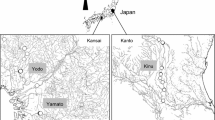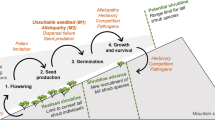Abstract
Natural disturbances have the potential to limit exotic species invasions. The exotic grass, Urochloa humidicola, has high propagation potential following seasonal flooding, but, flooding tends to reduce the cover. Neither the potential for U. humidicola form a seed bank for recruitment following seasonal flooding, nor the mechanism responsible for reducing adult plant cover during floods is currently known. The soil seed bank of a U. humidicola was sampled for 2 years. To examine the potential role of competition with aquatic macrophytes in reducing its cover during floods, cuttings of U. humidicola were flooded in tanks in presence and absence of aquatic macrophytes for 3 months. Seedling density of U. humidicola was higher post-flood (245 seedlings/m−2) than the post-dry (130 seedlings/m−2). Germination occurred throughout the year, with highest seedling densities at the five to 7 months following soil collection. Competition with aquatic plants significantly increased mortality (c. 70%) of inundated U. humidicola. Our findings suggest that the survival potential of U. humidicola under flood is high, but is limited by shading of aquatic macrophytes. Nonetheless, its seed bank germinates throughout the year, though delayed by flooding. Control of invasive species in grasslands of the Pantanal depend on natural hydrological and biological drives.




Similar content being viewed by others
References
Allem AC, Valls JFM (1987) Recursos forrageiros nativos do Pantanal Mato-grossense. Brasília, Embrapa-Cenargen. Documentos 8
Andrew SM, Totland O, Moe SR (2015) Spatial variation in plant species richness and diversity along human disturbance and environmental gradients in a tropical wetland. Wetlands Ecology and Management 23:395–404. https://doi.org/10.1007/s11273-014-9390-2
Bao F, Pott A, Ferreira FA, Arruda R (2014) Soil seed bank of floodable native and cultivated grassland in the Pantanal wetland: effects of flood gradient, season and species invasion. Brazilian Journal of Botany 37:239–250. https://doi.org/10.1007/s40415-014-0076-z
Bao F, Assis MA, Arruda R, Pott A (2015) Effects of Urochloa humidicola on plant diversity in native grasslands in a Neotropical wetland. Wetlands 35:841–850. https://doi.org/10.1007/s13157-015-0673-z
Bao F, Elsey-Quirk T, Assis MA, Pott A (2017) Seed bank of seasonally flooded grassland: experimental simulation of flood and post-flood. Aquatic Ecology 50:1–13. https://doi.org/10.1007/s10452-017-9647-y
Baruch Z (1994) Responses to drought and flooding in tropical forage grasses. Plant and Soil 164:87–96. https://doi.org/10.1007/BF00010114
Bates D, Maechler M, Bolker B, Walker S (2015) Fitting linear mixed-effects models using lme4. Journal of Statistical Software 67:1–48. https://doi.org/10.18637/jss.v067.i01
Blake RE, Duffy JE (2012) Changes in biodiversity and environmental stressors influence community structure of an experimental eelgrass Zostera marina system. Marine Ecology Progress Series 470:41–54. https://doi.org/10.3354/meps10006
Brock MA (2011) Persistence of seed banks in Australian temporary wetlands. Freshwater Biolology 56:1312–1327. https://doi.org/10.1111/j.1365-2427.2010.02570.x
Capon SJ (2007) Effects of flooding on seedling emergence from the soil seed bank of a large desert floodplain. Wetlands 27:904–914. https://doi.org/10.1672/0277-5212(2007)27%5B904:EOFOSE%5D2.0.CO;2
Capon SJ, Brock MA (2006) Flooding, soil seed bank dynamics and vegetation resilience of a hydrologically variable desert floodplain. Freshwater Biolology 51:206–223. https://doi.org/10.1111/j.1365-2427.2005.01484.x
Clarke PJ, Lawes MJ, Midgley JJ, Lamont BB, Ojeda F, Burrows GE, Enright NJ, Knox KJ (2013) Resprouting as a key functional trait: how buds, protection and resources drive persistence after fire. New Physiologist 197:19–35. https://doi.org/10.1111/nph.12001
Deane DC, Fordham DA, He F, Bradshaw CJA (2016) Diversity patterns of seasonal wetland plant communities mainly driven by rare terrestrial species. Biodiversity and Conservation 25:1569–1585. https://doi.org/10.1007/s10531-016-1139-1
Dias-Filho MB, Carvalho CJR (2000) Physiological and morphological responses of Brachiaria spp. to flooding. Pesquisa Agropecuária Brasileira 35:1959–1966
Dunn PK, Smyth GK (2005) Series evaluation of Tweedie exponential dispersion model densities. Statistics and Computing 15:267–280. https://doi.org/10.1007/s11222-005-4070-y
Fidelis A, Appezzato-da-Glória B, Pillar VD, Pfadenhauer J (2014) Does disturbance affect bud bank size and belowground structures diversity in Brazilian subtropical grasslands. Flora 209:110–116
Galatowitsch SM, Larson DL, Larson JL (2016) Factors affecting post-control reinvasion by seed of an invasive species, Phragmites australis, in the Central Platte River, Nebraska. Biological Invasions 18:2505–2516. https://doi.org/10.1007/s10530-015-1048-3
Gallardo B, Clavero M, Sánchez MI, Vilà M (2015) Global ecological impacts of invasive species in aquatic ecosystems. Global Change Biology 22:151–163. https://doi.org/10.1111/gcb.13004
Giner G, Smyth GK (2016) Statmod: probability calculations for the inverse Gaussian distribution. R Journal 8:339–351
Hamilton SK, Sippel SJ, Melack JM (1996) Inundation patterns in the Pantanal wetland of South America determined from passive microwave remote sensing. Archiv fur Hydrobiology 137:1–23
Harrington DP, Fleming TR (1982) A class of rank test procedures for censored survival data. Biometrika 69:553–566
Hejda M, Pysek P (2006) What is the impact of Impatiens glandulifera on species diversity of invaded riparian vegetation? Biological Conservation 132:143–152. dx.doi.org. https://doi.org/10.1016/j.biocon.2006.03.025
Hejda M, Pysek P, Jarosik V (2009) Impact of invasive plants on the species richness, diversity and composition of invaded communities. Journal of Ecology 97:393–403. https://doi.org/10.1111/j.1365-2745.2009.01480.x
Hejda M, Chytrý M, Pergl J, Pysek P (2015) Native-range habitats of invasive plants: are they similar to invaded-range habitats and do they differ according to the geographical direction of invasion? Diversity and Distributions 21:312–321. https://doi.org/10.1111/ddi.12269
Kaplan EL, Meier P (1958) Nonparametric estimation from incomplete observations. Journal American Statistic Association 53:457–481. https://doi.org/10.2307/2281868
Kelly VR, Parker VT (1990) Seed bank survival and dynamics in sprouting and nonsprouting Arctostaphylos species. The American Midland Naturalist 40:114–123. https://doi.org/10.2307/2426084
Kozlowski TT (1997) Responses of woody plants to flooding and salinity. Tree Physiology Monography 1:1–29. https://doi.org/10.1093/treephys/17.7.490
Lenth RV (2016) Least-squares means: the R package lsmeans. Journal of Statistical Software 69:1–33. https://doi.org/10.18637/jss.v069.i01
Lopes A, Parolin P, Piedade MTF (2016) Morphological and physiological traits of aquatic macrophytes respond to water chemistry in the Amazon Basin: an example of the genus Montrichardia Crueg (Araceae). Hydrobiologia 766:1–15. https://doi.org/10.1007/s10750-015-2431-x
Marcos Filho J, Cícero SM, Silva WR (1987) Avaliação da qualidade das sementes. Piracicaba: FEALQ. 230 p
Mattos JLS, Gomide JÁ, Huaman CAM (2005) Crescimento de espécies do gênero Brachiaria sob alagamento em casa de vegetação. Revista Brasileira de Zoologia 34:10–16. https://doi.org/10.1590/S1516-35982005000300007
Middleton BA (2003) Soil seed banks and the potential restoration of forested wetland after farming. Journal of Applied Ecology 40:1025–1034. https://doi.org/10.1111/j.1365-2664.2003.00866.x
Olden JD, Poff NL (2003) Toward a mechanistic understanding and prediction of biotic homogenization. The American Naturalist 162:442–460. https://doi.org/10.1086/378212
Oliveira PC, Torezan JM, Nunes da Cunha C (2015) Effects of flooding on the spatial distribuition of soil seed and spore banks of native grasslands of the Pantanal wetland. Acta Botânica Brasílica 29:400–407. https://doi.org/10.1590/0102-33062015abb0027
Pieterse AH, Murphy KJ (1990) Aquatic weeds. The ecology and management of nuisance aquatic vegetation. Oxford Science Publications, Oxford
Pott A, Ratter JA (2011) Species diversity of terrestrial plants and human impact on the vegetation of the Pantanal. In: Junk WJ, da Silva CJ, da Cunha CN, Wantzen KM (eds) The Pantanal Ecology, biodiversity and sustainable management of a large neotropical seasonal wetland. Pensoft Publishers, Sofia-Moscow, pp 281–300
Pott A, Silva JSV (2015) Terrestrial and aquatic vegetation diversity of the Pantanal wetland. In: Bergier I, Assine ML (eds) Dynamics of the Pantanal wetland in South America. The Handbook of Environmental Chemistry, vol 37, pp 111–131. https://doi.org/10.1007/6982015352
R Core Team (2016) R: A language and environment for statistical computing. R Foundation for Statistical Computing, Vienna, Austria. URL https://www.R-project.org/. Accessed 5 Oct 2016
Rodríguez M, Brisson J (2015) Pollutant removal efficiency of native versus exotic common reed (Phragmites australis) in North American treatment wetlands. Ecological Engineering 74:364–370. https://doi.org/10.1016/j.ecoleng.2014.11.005
Rojas IM, Zedles JB (2015) An invasive exotic grass reduced sedge meadow species richness by half. Wetlands Ecology and Management 23:649–663
Silva JSV, Abdon MM (1998) Delimitação do Pantanal Brasileiro e suas sub-regiões. Pesquisa Agropecuária Brasileira 33:1703–1711
Smyth G, Jørgensen B (2002) Fitting Tweedie’s compound poisson model to insurance claims data: dispersion modelling. ASTIN Bulletin 32:143–157
Soares Filho C.V. Recomendações de Espécies e Variedades de Brachiaria para diferentes condições, 1994. In: Anais XI Simpósio Sobre Manejo de Pastagem. Piracicaba - SP: FEALQ, pp 25–48
Souza EB, Ferreira FA, Pott A (2016) Effects of flooding and its temporal variation on seedling recruitment from the soil seed bank of a Neotropical floodplain. Acta Botânica Brasílica 31:64–75. https://doi.org/10.1590/0102-33062016abb0202
Therneau T (2015) A Package for Survival Analysis in S. version 2.38 https://CRAN.R-project.org/package=survival. Accessed 5 Oct 2016
Thompson K, Bakker JP, Bekker RM (1997) The soil seed banks of North West Europe: methodology, density and longevity. University Press, Cambridge, p 288p
Urban RA, Titus JE, Zhu WX (2006) An invasive macrophyte alters sediment chemistry due to suppression of a native isoetid. Oecologia 148:455–463. https://doi.org/10.1007/s00442-006-0393-4
Valle CB, Jank L, Resende RMS (2015) O melhoramento de forrageiras tropicais no Brasil. Ceres 56:1–4
Venable DL (1989) Modeling the evolutionary ecology of seed banks. In: Leck MA, Parker VT, Simpson RL (eds) Ecology of soil seed banks. Academic Press, London, pp 67–88
Wang W, Wang C, Sardans J, Tong C, Jia R, Zeng C, Penuelas J (2015) Flood regime affects soil stoichiometry and the distribution of the invasive plants in subtropical estuarine wetlands in China. Catena 128:144–154. https://doi.org/10.1016/j.catena.2015.01.017
Yarwood SA, Baldwin AH, Gonzalez MM, Buyer JS (2016) Archaeal rhizosphere communities differ between the native and invasive lineages of the wetland plant Phragmites australis (common reed) in a Chesapeake Bay subestuary. Biological Invasions 18:2717–2728. https://doi.org/10.1007/s10530-016-1144-z
Acknowledgements
The authors thank to the Brazilian governmental agency CNPq (Conselho Nacional de Desenvolvimento Científico e Tecnológico, or “National Counsel of Technological and Scientific Development”) for the scholarship (F. Bao – n° 151326) and research grants (A. P. and M. A. A.).
Author information
Authors and Affiliations
Corresponding author
Additional information
Publisher’s Note
Springer Nature remains neutral with regard to jurisdictional claims in published maps and institutional affiliations.
Electronic supplementary material
Fig S1
Mean monthly level of the Miranda River, arrows showing the sampled seasonal periods (post-dry and post-flood), between the years 2005–2015 (a); Representation of the transects following the topographic levels (low, mid and high) in each sampled pond, with five random samples (b). (PNG 434 kb)
High Resolution Image
(TIF 45 kb)
Fig S2
Scheme of organization of trays in water tanks in the different treatments: submersion with absence of aquatic plants (a) and; in the presence of aquatic plants (b). (PNG 3001 kb)
High Resolution Image
(TIF 629 kb)
Rights and permissions
About this article
Cite this article
Bao, F., Elsey-Quirk, T., de Assis, M.A. et al. Do Aquatic Macrophytes Limit the Invasion Potential of Exotic Species in Pantanal Grasslands?. Wetlands 40, 135–142 (2020). https://doi.org/10.1007/s13157-019-01168-5
Received:
Accepted:
Published:
Issue Date:
DOI: https://doi.org/10.1007/s13157-019-01168-5




